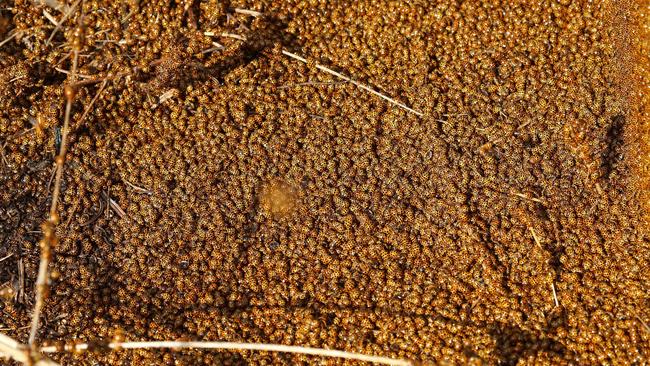Millions of ladybirds swarm Wandilo Forest Rd at Dismal Swamp, about 20km from Mt Gambier
While you might see one or two of these critters in your backyard, an area in the state’s South East has been taken over by millions of insects. See the pictures.

Mount Gambier
Don't miss out on the headlines from Mount Gambier. Followed categories will be added to My News.
Millions of swarming ladybirds have taken over an area in South Australia’s South East.
Photos captured by amateur photographer Darren Archibald, depict the insects covering power poles along Wandilo Forest Rd at Dismal Swamp, about 20km from Mt Gambier.
Mr Archibald, 53, said while ladybirds often appear in the area flanked by pine forests, he had never seen so many.
“It’s really interesting because in your garden you might see two or three at a time but it’s just a heaving pile that’s moving,” he said.
“Along that road there would be 20 power poles and nearly every one has masses and masses on them and it’s like a beehive.”
While taking photos, hundreds landed on Mr Archibald, from Mt Gambier, and “when they get on you it’s like your skin is crawling”.
“There’s quite a few flying around,” he said.
Mr Archibald encouraged people “go see them” but warned there was “a real beetle like smell” around the area.
“They don’t seem to hang around for a long time,” he said.
Mr Archibald had previously seen the phenomenon, although not in the same numbers, and said the insects only stay for up to a two-week period.
“It’s nice to see they’re back in such numbers,” he said.



University of Adelaide insect expert Dr Gary Taylor said the ladybirds could be congregating due to multiple factors including weather conditions and an abundance of food.
“They’re able to prey on the pine aphid there and the trees are stressed (due to drought) down there which is making the aphid population build up,” Dr Taylor said.
Each year, the insects congregate at the end of summer.
“They have to survive the cold winter months so they hibernate there,” he said.
“They could be responding to the lowering of temperatures.”
But there are “natural fluctuations which aren’t consistent year on year” in bug populations.
“One year you might have one tenth the population and another year the conditions might be good and people notice it,” he said.
The insects create “safety in numbers” by swarming together.
“I was absolutely amazed as I heard they were two or three inches thick on the ground,” Dr Taylor said.
He had not heard of the phenomenon occurring anywhere else in the state.
But there had been similar observations with other insects as the red bug population had exploded in the Riverland in the last few weeks with dry conditions and cooler weather.




